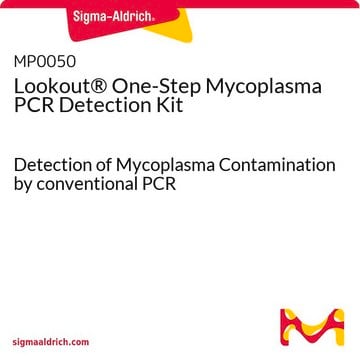MP0035
LookOut® Mycoplasma PCR-Detektions-Kit
Optimized for use with JumpStart™ Taq DNA Polymerase, D9307.
Synonym(e):
PCR-based mycoplasma screening
About This Item
Empfohlene Produkte
Qualität
Not suitable for clinical diagnostic use. Will not detect clinically relevant species such as M. pneumoniae and U. urealyticum
Verpackung
pkg of 1 kit
Methode(n)
PCR: suitable
Anwendung(en)
detection
microbiology
Kompatibilität
Optimized for use with JumpStart™ Taq DNA Polymerase, D9307.
Lagertemp.
2-8°C
Allgemeine Beschreibung
Die mit dem Kit gelieferten Reaktionsröhrchen sind mit entsprechenden dNTPs, Primern und Ladefarbstoff vorbeschichtet. Die Gesamtassayzeit ist im Vergleich zu allgemeinen Protokollen, die eine individuelle Beschickung der Reaktionsröhrchen erfordern, deutlich reduziert.
Anwendung
Kompatibilität
Rechtliche Hinweise
Ähnliches Produkt
Lagerklassenschlüssel
10 - Combustible liquids
Flammpunkt (°F)
Not applicable
Flammpunkt (°C)
Not applicable
Analysenzertifikate (COA)
Suchen Sie nach Analysenzertifikate (COA), indem Sie die Lot-/Chargennummer des Produkts eingeben. Lot- und Chargennummern sind auf dem Produktetikett hinter den Wörtern ‘Lot’ oder ‘Batch’ (Lot oder Charge) zu finden.
Besitzen Sie dieses Produkt bereits?
In der Dokumentenbibliothek finden Sie die Dokumentation zu den Produkten, die Sie kürzlich erworben haben.
Kunden haben sich ebenfalls angesehen
Artikel
Detect mycoplasma contamination in cell culture through the PCR, DNA stain, or culture tests. Discover mycoplasma prevention, elimination, and detection kits.
Overview on how to maintain proper cell culture laboratory safety including steps on performing lab risk assessments, surface disinfection, biohazard and waste removal. Free ECACC handbook download.
Overview of good cell banking practices for cell line cryopreservation purposes.
Quality control guidelines to maintain high quality authenticated and contamination-free cell cultures. Free ECACC handbook download.
Protokolle
Mycoplasma contamination of cell cultures is a serious issue impacting cell model validity. PCR testing for mycoplasma is an inexpensive, sensitive, and specific method for detecting contamination.
Unser Team von Wissenschaftlern verfügt über Erfahrung in allen Forschungsbereichen einschließlich Life Science, Materialwissenschaften, chemischer Synthese, Chromatographie, Analytik und vielen mehr..
Setzen Sie sich mit dem technischen Dienst in Verbindung.






